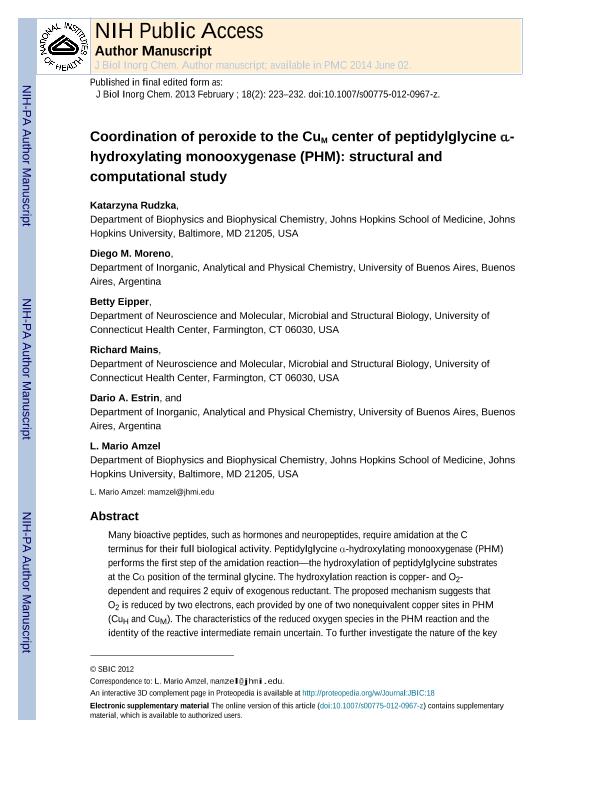Mostrar el registro sencillo del ítem
dc.contributor.author
Rudzka, Katarzyna
dc.contributor.author
Moreno, Diego Martin

dc.contributor.author
Eipper, Betty
dc.contributor.author
Mains, Richard
dc.contributor.author
Estrin, Dario Ariel

dc.contributor.author
Amzel, L. Mario
dc.date.available
2016-07-04T18:29:01Z
dc.date.issued
2013-02
dc.identifier.citation
Rudzka, Katarzyna; Moreno, Diego Martin; Eipper, Betty; Mains, Richard; Estrin, Dario Ariel; et al.; Coordination of peroxide to the CuM center of peptidylglycine α-hydroxylating monooxygenase (PHM): Structural and computational study; Springer; Journal of Biological Inorganic Chemistry; 18; 2; 2-2013; 223-232
dc.identifier.issn
0949-8257
dc.identifier.uri
http://hdl.handle.net/11336/6330
dc.description.abstract
Many bioactive peptides, such as hormones and neuropeptides, require amidation at the C terminus for their full biological activity. Peptidylglycine a-hydroxylating monooxygenase (PHM) performs the first step of the amidation reaction-the hydroxylation of peptidylglycine substrates at the Ca position of the terminal glycine. The hydroxylation reaction is copper- and O2-dependent and requires 2 equiv of exogenous reductant. The proposed mechanism suggests thatO2 is reduced by two electrons, each provided by one of two nonequivalent copper sites in PHM (CuH and CuM). The characteristics of the reduced oxygen species in the PHM reaction and the identity of the reactive intermediate remain uncertain. To further investigate the nature of the key intermediates in the PHM cycle, we determined the structure of the oxidized form of PHM complexed with hydrogen peroxide. In this 1.98-A° -resolution structure (hydro)peroxide binds solely to CuM in a slightly asymmetric side-on mode. The O-O interatomic distance of the copperbound ligand is 1.5 A ° , characteristic of peroxide/hydroperoxide species, and the Cu-O distances are 2.0 and 2.1 A ° . Density functional theory calculations using the first coordination sphere of the CuM active site as a model system show that the computed energies of the side-on L3CuM(II)-O2 2- species and its isomeric, end-on structure L3CuM(I)-O2 - are similar, suggesting that both these intermediates are significantly populated within the protein environment. This observation has important mechanistic implications. The geometry of the observed side-on coordinated peroxide ligand in L3CuM(II)O2 2- is in good agreement with the results of a hybrid quantum mechanical-molecular mechanical optimization of this species.
dc.format
application/pdf
dc.language.iso
eng
dc.publisher
Springer

dc.rights
info:eu-repo/semantics/openAccess
dc.rights.uri
https://creativecommons.org/licenses/by-nc-sa/2.5/ar/
dc.subject
AMIDATION OF PEPTIDES
dc.subject
COPPER-CONTAINING PROTEINS
dc.subject
PEPTIDYLGLYCINE Α-HYDROXYLATING MONOOXYGENASE
dc.subject
PEROXIDE
dc.subject.classification
Físico-Química, Ciencia de los Polímeros, Electroquímica

dc.subject.classification
Ciencias Químicas

dc.subject.classification
CIENCIAS NATURALES Y EXACTAS

dc.title
Coordination of peroxide to the CuM center of peptidylglycine α-hydroxylating monooxygenase (PHM): Structural and computational study
dc.type
info:eu-repo/semantics/article
dc.type
info:ar-repo/semantics/artículo
dc.type
info:eu-repo/semantics/publishedVersion
dc.date.updated
2016-06-01T13:50:13Z
dc.journal.volume
18
dc.journal.number
2
dc.journal.pagination
223-232
dc.journal.pais
Alemania

dc.journal.ciudad
Berlin
dc.description.fil
Fil: Rudzka, Katarzyna. University Johns Hopkins; Estados Unidos
dc.description.fil
Fil: Moreno, Diego Martin. Consejo Nacional de Investigaciones Científicas y Técnicas. Centro Científico Tecnológico Rosario. Instituto de Química Rosario; Argentina. Universidad de Buenos Aires; Argentina
dc.description.fil
Fil: Eipper, Betty. University Of Connecticut; Estados Unidos
dc.description.fil
Fil: Mains, Richard. University Of Connecticut; Estados Unidos
dc.description.fil
Fil: Estrin, Dario Ariel. Consejo Nacional de Investigaciones Científicas y Técnicas. Oficina de Coordinación Administrativa Ciudad Universitaria. Instituto de Química, Física de los Materiales, Medioambiente y Energía; Argentina. Universidad de Buenos Aires; Argentina
dc.description.fil
Fil: Amzel, L. Mario. University Johns Hopkins; Estados Unidos
dc.journal.title
Journal of Biological Inorganic Chemistry

dc.relation.alternativeid
info:eu-repo/semantics/altIdentifier/doi/http://dx.doi.org/10.1007/s00775-012-0967-z
dc.relation.alternativeid
info:eu-repo/semantics/altIdentifier/url/http://link.springer.com/article/10.1007%2Fs00775-012-0967-z
dc.relation.alternativeid
info:eu-repo/semantics/altIdentifier/url/https://www.ncbi.nlm.nih.gov/pmc/articles/PMC4041156/
Archivos asociados
